Review by Lutz Bendlin
Globalsat BT338 receiver with SiRFstarIII chipset
We have already announced this new chipset a while back, and now we start seeing the first devices that are actually using that chipset. www.BuyGPSNow.com were so kind to provide us with a review copy of the Globalsat BT338 receiver that uses the SiRFstar III chipset..
The Chipset
Those of you who have followed the personal GPS area closely will remember that initially there were only two chipset providers – Evermore and SiRF. Nowadays there are many more companies playing in that market, including Infineon, Sony, Fujitsu and many others.
So SiRF really had to stretch to keep their market share. According to the marketing blurb at www.sirf.com the new “SiRFstar III” has a radically different design:
“With its rapid time-to-first-fix and high sensitivity, the SiRFstarIII architecture is designed to meet the rigorous demands of wireless and handheld LBS applications, and provides superior location performance, both indoors and out, for 2G, 2.5G, 3G asynchronous networks.
The SiRFstarIII architecture packs a performance punch, achieving time-to-first-fix of one second for aided starts in outdoor GSM environments and acquiring signals down to -159 dBm. This makes real-time navigation practical, including in many indoor environments, through urban canyons, and under dense foliage. Unlike the lengthy sequential search process of traditional GPS architectures, the SiRFstarIII architecture, with the equivalent of more than 200,000 correlators, enables fast and deep GPS signal search capabilities, resulting in significant improvement over today's architectures that contain a few hundred to a few thousand correlators.”
One second TTFF? That would be something… As we have seen in the past one of the main annoyances with GPS devices is the long time it takes them to acquire a fix when the device was switched off for a longer time (longer than a few minutes). This is mostly due to the fact that the satellites have moved on, and the receiver needs to get a new set of trajectory information to start acquiring the satellites.
The new chipset has two ways to improve on this. Firstly, it uses more channels (20 instead of the standard 12) to collect signals, and secondly it is able to work together with mobile networks to offload some of the computing work for the initial fix to a central server. This is called AGPS ( assisted GPS) . It works pretty simple. Via the mobile network the receiver position can be determined easily – it's in the range of the cell that it is booked into. The mobile network server can then quickly provide the receiver with the base GPS data (atomic time, almanac, ephemeris) and the receiver can then spend all its computing power on the actual position lock.
This is indeed a radical shift away from a “GPS receiver is always on” paradigm to a kind of “Push to Fix” paradigm where the GPS position is determined only when it is requested. This is not so much important for navigation, but it certainly is very good for Location Based Services and for devices that have limited computing power and battery capacity.
Now what about the BT338 – does it have a mobile phone interface? No, this receiver is purely GPS, not AGPS. So TTFF of one second is not possible. However, the other features of the chipset (20 channels, 200000 correlators) still gives a much improved TTFF, and you can already get a feeling of what it is like to be able to get into your car, switch on the GPS receiver, and start navigating by the time you pull out of the parking spot.
The below spot measurements have been taken indoors, in the middle of my house. The TomTom BT GPS shows an astonishingly good performance. It also looks like its antenna is tuned well. The DeLorme Blue Logger takes very long to get a fix. The GlobalSat tracks more satellites than the TomTom unit, and it can hold onto them at lower signal levels, too.

Globalsat BT338
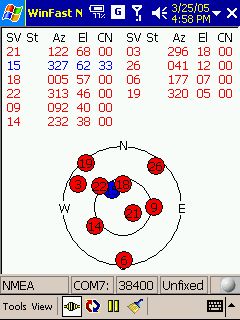
DeLorme Blue Logger
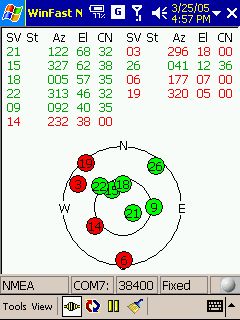
TomTom BT GPS
The new chipset also features a different approach to the usage of the actual satellite signal. Where standard receivers require a signal strength of at least 28 dB to even consider a satellite for correlation the SiRFstarIII chipset will basically use any signal it can get, down to 13 dB. Thanks to its 20 channel receiver it will also be able to use signals that are bouncing off buildings (especially in urban canyons, but also indoors) and include them into the correlation.
This is similar to the way that XTrac works on the SiRF II chips, but without the negative side effects. Where the SiRF II/XTrac chips tended to “overshoot” position and generally took more time to calculate position the new SiRF III is staying close to the course you are driving, no matter how hard you accelerate or brake or turn.
Due to the fact that it can use such low signal levels the new chipset is also performing better under foliage, in urban canyons, and indoors. It basically scratches every single bit of signal off the wall and uses it for the correlation.
This approach of course also comes at a price. If you use such low signal levels, you will also get some pretty bad signals that will make your position jump around quite a bit when you are stationary or moving slowly. SiRF's answer against that is called “Static Navigation” and it is a feature of the chipset that freezes your position when you are moving slower than 4 km/h . Position changes will only be registered when the difference exceeds 50 meters. As a result when you walk slowly your position seems to be frozen and it updates only every once in a while.
Sounds familiar? Indeed, this feature was also present in the XTrac chipset, and it caused some grief with the pedestrians and Geocachers. Fortunately this feature can be switched off with a tool called SiRFDemo. Guillaume over at GpsPasSion has written a brief tutorial on how to use SiRFDemo - http://www.gpspassion.com/forumsen/topic.asp?TOPIC_ID=25575 (you need a Bluetooth enabled PC for that)
We have heard that the current batch of BT338 receivers are delivered with Static Navigation disabled, so you should not even see that effect any more.
SBAS
So far I was unable to switch the receiver to SBAS mode. Not sure if this is due to the firmware or if SiRFstarIII in general doesn't support SBAS (Satellite Based Augmentation System), like the XTrac receivers. Anyone has managed to do that?
The Globalsat BT338 receiver
This receiver is pleasantly different from the standard range of dull black boxes. The silver body is well shaped, and finds approval even by the fashion conscious public.
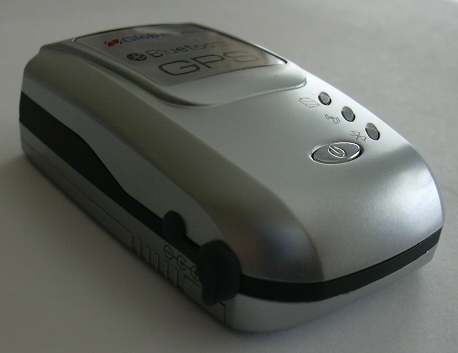
Another plus is the silver finish. Where I live it's always better to have devices with lighter colored bodies that do not heat up as much when being exposed to direct sunlight, for example in a parking lot.
One thing I personally don't like is the identification of the device's purpose on the top of the body (it says “GlobalSat Bluetooth GPS”) – it just gives away the opportunity too easily. Better do not leave the device unattended in the car, definitely not in open view.
Thanks to its superior performance you may even be able to keep the unit in the glove compartment at most times – you only need to touch it to switch it on, and then you can hide it again.
An increasingly important fashion detail – the lanyard ring at the top of the receiver that allows you to hang the BT338 around your neck.
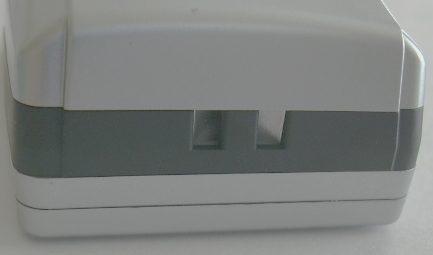
The inner works
Well, we couldn't stop it and had to open the receiver. The perception of quality extends to the components – all appear very well designed and produced. The receiver may not be waterproof but it will certainly survive a splash or two.
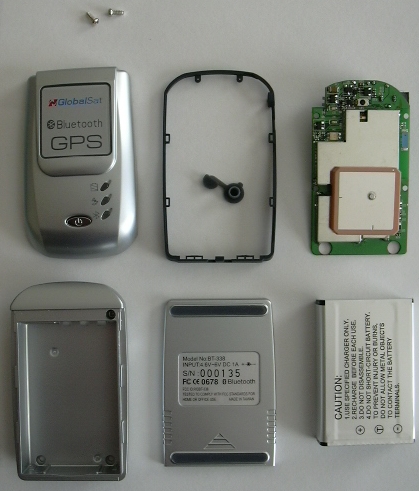
The LEDs
On the top of the body are the standard usage elements – three LEDs and a software power button.
Since the beginning of time we are fighting with device manufacturers over the way LEDs are working on GPS receivers. We think that a working state should be indicated either by a steady light or by no light at all. If something's not working (no BT link, no GPS fix, battery low) this should be indicated by a blinking light.
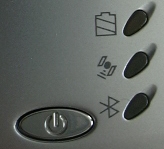
Sadly, the BT338 works exactly the other way round. A solid green LED means that no GPS fix has been reached yet, and a blinking green LED indicated the fix. The blue LED blinks slowly without a BT connection, and it blinks more rapidly when a connection is established.
At least the battery LED is blinking when you're low on power…
The Power stuff
The software power on switch is making this receiver unsuitable for permanent wiring in car, but it also has an interesting feature. When the Bluetooth connection is severed while the BT338 is running the device will switch itself off after 10 minutes. Pretty smart when you use it in the car because then you got rid of one action – you don't need to explicitly switch the device off.. (Of course you can still do that if you want to) . So the only action you need to remember is to press the power button to switch the receiver on – after that it's working seamlessly.
If you are hiking with the device and a Pocket PC, and tend to switch the Pocket PC off to save energy, then you may at first find it annoying that the GPS receiver switches itself off too. But on the other hand the time to re-fix is so short that it nearly doesn't matter – simply press the power button, and after very few seconds (on average three to five) you got your fix. As mentioned before, this is really starting to demonstrate the concept of “Push-to-fix”.
The BT338 has a replaceable battery, and it's huge. The battery has a capacity of 1700 mAh ( more than most Pocket PCs) and easily outweighs all the other components of the BT338. GlobalSat claim a runtime of 17 hours in standard mode and 20+ hours in trickle mode (something you can also set via SiRFDemo). Our tests are still running, but it really seems to pull the 17 hours off with ease. What more do you want…

The power connector is of the friendly 5V type (iPAQ etc) so depending on your Pocket PC device you may be able to save some cabling and power adapters. The power jacket is covered with a little rubber thingie, more a nice gimmick than really useful.
Performance on the road
After the initial disappointment in walking mode (which fortunately could be fixed by switching off Static Navigation) I must say that I am truly impressed by the receiver. Much better TTFF than any other device I have tested so far, better reception in difficult conditions like indoors or under heavy foliage, and rock-solid fixes even when put into the glove compartment of the car, something I couldn't do with any other receiver.
So far I was unable to completely explore the battery runtime, also thanks to the clever power save feature. You can assume that this receiver reaches the same operating time as your average cell phone, and only needs to be recharged every week. |